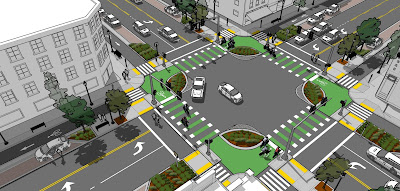 |
| Existing bulb-outs may interfere with bike lanes |
About bulb-outs (or "curb extensions" generally), the National Association of City Transportation Officials, a group more focused on walking, biking, and busing than more highway-oriented groups or agencies like AASHTO and FHWA - and a group whose standards should be adopted by the City! - says:
- Curb extensions visually and physically narrow the roadway, creating safer and shorter crossings for pedestrians while increasing the available space for street furniture, benches, plantings, and street trees.
- Decrease the overall width of the roadway and can serve as a visual cue to drivers that they are entering a neighborhood street or area.
- Increase the overall visibility of pedestrians by aligning them with the parking lane and reducing the crossing distance for pedestrians, creating more time for preferential treatments such as leading pedestrian interval and transit signal priority.
- Tighten intersection curb radii and encourage slower turning speeds.
Mostly our implementation of bulb-outs has kept the auto travel lanes unaffected. They are not installed in the context of a total street redesign. They have been more incremental, and then subsequent redesigns have had to work around them.
 |
| Protected bike lane between Ferry and Trade on High Street The near corner on Ferry has a bulb-out, the far corner does not (Compare to concept drawing from 2013 just below) |
 |
| The plan from 2013, modified as built - notes added (Also, upside down relative to photo just above!) |
(Other things to note: Our doctrine of free and copious auto parking is also involved here. But also! Rather quietly, the City made a significant improvement to the striping plan between 2013 and 2016, and in contrast to the City's intransigence on things like the Salem River Crossing they did a good thing here!)
In order to have bike lanes that attract a broader group of users, it will still be necessary for Salem to protect bike lanes more thoroughly, and it was a real renunciation to have the protected bike lane on only one block length out of 14 or so total on Church and High.
It's time to think more deeply about our downtown autoism.
One tremendous recent example of a redesign is on Telegraph Avenue in Oakland. It takes a wide street, not unlike our Liberty/Commercial couplet, and improves it greatly for non-auto users.
 |
| Telegraph Avenue Redesign City of Oakland (Click to enlarge) |
But there are ways to include bike lanes and also to shorten crosswalk distances.
Here's another redesign for a wide road full of two-story commercial buildings, very much like those on Liberty/Commercial or Court/State.
 |
| Urban Street redesign with protected bike lanes (NACTO design guides) |
 |
| Schematic for Protected Intersection Alta Planning, December 2015 |
 |
| Another protected intersection rendering (click to enlarge) via Twitter at the #ATsummit2017 |
 |
| I think this was the last public concept for State Street Bulb-outs and standard bike lanes (see shaded sections) From the June 13th, 2013 Open House |
We could use paint and plastic wands to pilot some different treatments if we wanted to experiment some first.
 |
| Polka dots pilot a curb extension, and are more pretty! |
 |
| If you can stage photos like this on Liberty at State, that's evidence we have excess road capacity! (via Downtown Salem fansite) |
Also, at the last meeting of the DAB, Salemites with the Oregon Main Street Program asked for, and were rebuffed in, a request for $50,000:
Representatives from Salem Main Street Association, a newly created downtown association requested $50,000 in Parking Budget Funds to start up their organization. Currently, $32,150 are budgeted within the Parking budget for Contracted Services. The DAB voted to not amend the recommended budget to increase that line item.So are they going to get the $32,150? The notes are too laconic!
In any case, apparently there will be a meeting next month:
Salem Main Street Community Information MeetingThere has been some concern that this group is operating a little too much under the radar.
Thursday, April 20, from 6:30-8:00 p.m., at the IKE BOX, 299 Cottage St. NE, on the 2nd floor.
It will be good to learn more about what they are working on. In general terms the Main Street Program is a good thing!
The Downtown Advisory Board meets Thursday the 23rd, from 12:00 pm – 1:30 pm in the Urban Development Conference Room, 350 Commercial St NE, underneath the Chemeketa Parkade.


No comments:
Post a Comment